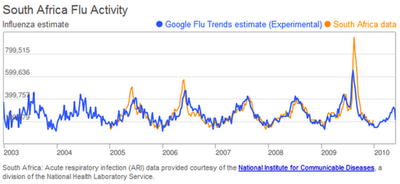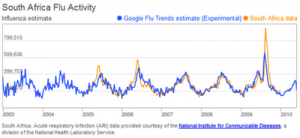Launched first in the US in November 2008, Google flu trends proved to be a powerful tool for accurately estimating the level of flu activity in a country in near real-time. Google Flu Trends was expanded to much of Europe last year in advance of the winter flu season, Google is now announcing the launch of Google Flu Trends in eight additional countries in the southern hemisphere where winter has set in, including South Africa.
Being able to track increases in flu activity has proved to be a valuable resource to public health officials, doctors, health ministries, and regular people, and can help us all respond more quickly to flu outbreaks. This can be especially important when people from around the world converge in one place, like in South Africa during the world cup season. South Africa is the first country google is adding in Africa, comparing their data with data provided in the public domain through the National Institute for Communicable Diseases (NICD), a division of the National Health Laboratory Service.
Many health agencies already survey doctors and patients to track the flu, so you might ask, why bother with estimates from aggregated search queries? Traditional flu surveillance is very important, but most health agencies focus on a single country or region and only update their estimates once per week, often with a lag-time of weeks. Google Flu Trends is currently available for a number of countries around the world and is updated every day, providing a complement to these existing systems.
For epidemiologists, this is an exciting development, because early detection of a disease outbreak can reduce the number of people affected. If a new strain of influenza virus emerges under certain conditions, a pandemic could ensue with the potential to cause millions of deaths.
Google Flu Trends is one example of how people’s searches can be a reflection of what’s happening in a country, and can provide a key to responding to threats to public health.






























